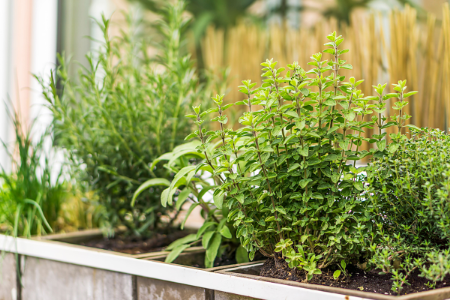
An herb garden is a perfect way to exercise your green thumb and produce a delicious product that can be used in virtually any dish you cook. There are a few decisions you’ll need to work through before getting started, such as whether you want to plant the garden indoors or outdoors. Then you can decide on the herbs and learn how to care for them. If it sounds like a lot, don’t worry, herbs are one of the easiest things to grow. Plus, we’ve broken down everything you need to know right here!
The Rundown on Herb Gardens
Herb gardens are typically made up of a number of different herbs, with popular plants like basil, rosemary, thyme, parsley, oregano, and dill. There are plenty of benefits for owning an herb garden, including easy access to extra flavor, and avoiding the expense associated with fresh herbs from the grocery store. The benefits don’t stop there. Gardening is shown to reduce stress. Surrounding oneself with greenery and taking the time to slow down and tend to something helps us to unwind. In operating a little herb garden, you’re relaxing, moving your body, and enjoying the health benefits of the herbs themselves!
Step One: Inside or Outside
If you’re looking for something flexible and diverse, herbs are the way to go as they work both indoors and outdoors.
In the case of outdoor gardening, your herbs will have space to grow while utilizing fresh air and sunlight. The disadvantage of outdoor gardening depends on geography. If you live in an area with cold winters or extremely hot summers, then your herbs may struggle during those extremes. Additionally, you will have to take steps to prevent pets and pests from getting into the herbs.
For indoor herb gardening, the setup will be much smaller as space is limited, but you can fit them into your kitchen’s style. They can make quite the décor. Additionally, you won’t need to go outside to harvest because the herbs are well within reach. The downside to growing indoors is that the plants need sunlight, so you’ll need to keep them in the windowsill or a similar well-lit area. If your kitchen doesn’t receive much light, outdoors or another room may be a better location for the garden.
Step Two: Planning the Garden
After you’ve chosen indoors or outdoors, it’s time to choose the herbs you’ll be growing. It’s important to do this after deciding location because some will thrive better indoors versus outdoors and vice versa. For outdoor herb gardens, consider:
- Chives
- Coriander
- Dill
- Fennel
- Mint
- Parsley
- Rosemary
- Tarragon
For your indoor herb gardens, set up an adorable display centered around these herbs:
- Basil
- Bay leaf
- Cilantro
- Lemongrass
- Oregano
- Sage
- Thyme
That’s not to say that these herbs couldn’t work in the opposite location, but this is generally where each of the herbs thrive. You will also be able to choose between new seeds, seedlings, or already formed plants when starting your garden. For example, you may be able to find a basil plant at your local supermarket that can sit in your kitchen and reproduce, or you can buy packs of seeds from a gardening store and start from scratch.
Step Three: Care
Unlike other complicated plant types that require constant care and delicate attention, herbs are resilient if you make sure a few core components are cared for. Herbs need:
Well-Drained Soil
The number one issue with herbs is soggy soil. If your soil stays moist for too long and you overwater, you run the risk of killing your plants. If your soil does not drain well, it’s best to build a separate, raised garden bed to grow your herbs to give the best chance at success. This may also help to keep pets and little ones away from the garden. For indoor gardens, use pots with holes at the bottom or gravel beneath the soil so the excess water can escape. Check on each type of herb’s unique needs so you can water accordingly.
Sunlight
Generally, herbs need full sun for at least 8 hours a day, though you’ll want to check with each type you’re planting to be sure. That means unobstructed, shade-free sunshine during the day. It’s best to observe the sun and shade habits around your home to make sure that halfway through the day, your home doesn’t cast shade in the place you hope to plant your herb garden.
Step Four: Harvesting
The best tips for harvesting herbs will depend on the actual herbs used. Generally, herbs should be harvested when the plant has enough foliage to replenish itself. It’s best to never cut more than 50% of the plant for annual herbs, and with perennials, never more than 33%. If you have a surplus and would like to dry for later use, simply lay out the harvested herbs and let them dry completely, or dry on low heat before grinding them or storing them for later use.
Step Five: Enjoy
There you have it! A fun, easy-to-do method for growing a robust herb garden. While there are a few decisions to make upfront, it is relatively smooth sailing from there!
